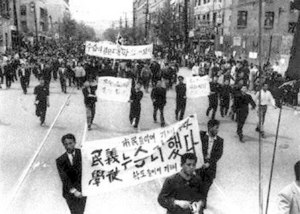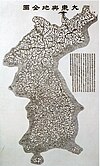| April Revolution | |||
|---|---|---|---|
 Protesters during the April Revolution | |||
| Date | April 11–26, 1960 | ||
| Location | South Korea | ||
| Caused by |
| ||
| Resulted in |
| ||
| Parties | |||
| |||
| Lead figures | |||
| |||
| Casualties and losses | |||
| 186 civilians | |||
| History of South Korea |
|---|
 |
|
|
The April Revolution (Korean: 4.19 혁명), also called the April 19 Revolution or April 19 Movement, were mass protests in South Korea against President Syngman Rhee and the First Republic from April 11 to 26, 1960, which led to Rhee's resignation.[1]
Protests opposing Rhee were started by student and labor groups in the southeastern port city of Masan on April 11. The protests were triggered by the discovery of the body of a local high school student killed by police during demonstrations against rigged elections in March. Popular discontent had arisen due to Rhee's autocratic rule, corruption, use of violence against political opposition, and uneven development of South Korea. The Masan discovery led to large student protests in Seoul, which were violently suppressed; a total of 186 people were killed during the two weeks of protest.[2] Rhee resigned on April 26 before fleeing to exile in the United States, and was replaced by Yun Posun, beginning the transition to the Second Republic of South Korea.
- ^ "South Korean students force dictator to resign, new elections, 1960 | Global Nonviolent Action Database". nvdatabase.swarthmore.edu. Retrieved February 11, 2021.
- ^ "Remembering the April 19 Revolution". The Dong-A Ilbo. Retrieved August 21, 2019.